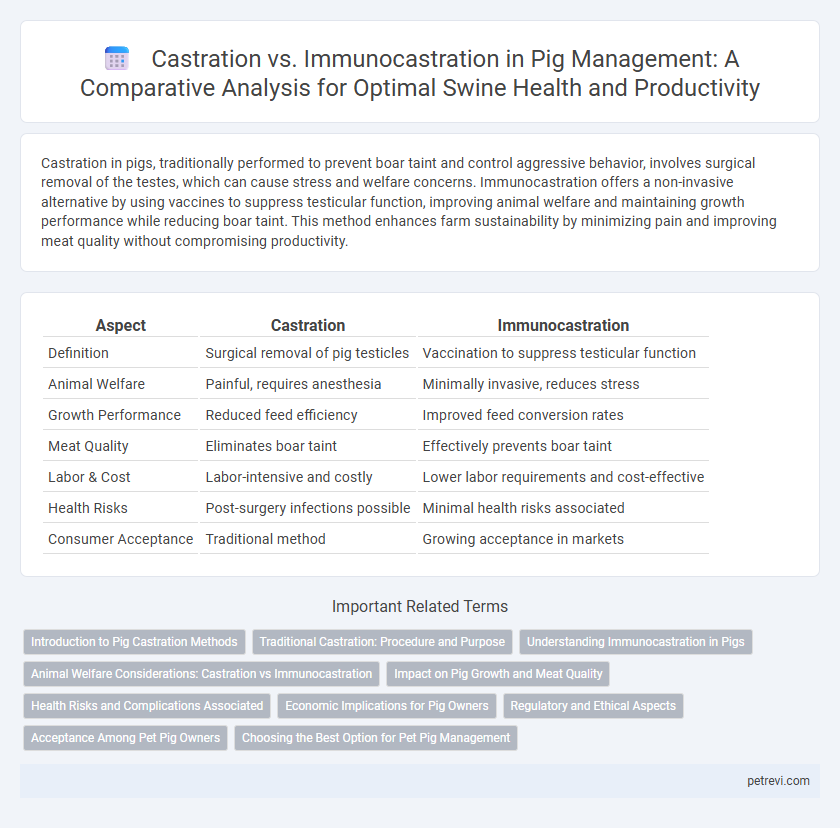Castration in pigs, traditionally performed to prevent boar taint and control aggressive behavior, involves surgical removal of the testes, which can cause stress and welfare concerns. Immunocastration offers a non-invasive alternative by using vaccines to suppress testicular function, improving animal welfare and maintaining growth performance while reducing boar taint. This method enhances farm sustainability by minimizing pain and improving meat quality without compromising productivity.
Table of Comparison
| Aspect | Castration | Immunocastration |
|---|---|---|
| Definition | Surgical removal of pig testicles | Vaccination to suppress testicular function |
| Animal Welfare | Painful, requires anesthesia | Minimally invasive, reduces stress |
| Growth Performance | Reduced feed efficiency | Improved feed conversion rates |
| Meat Quality | Eliminates boar taint | Effectively prevents boar taint |
| Labor & Cost | Labor-intensive and costly | Lower labor requirements and cost-effective |
| Health Risks | Post-surgery infections possible | Minimal health risks associated |
| Consumer Acceptance | Traditional method | Growing acceptance in markets |
Introduction to Pig Castration Methods
Pig castration methods primarily include surgical castration and immunocastration, each targeting the reduction of boar taint and aggressive behavior. Surgical castration involves the physical removal of testes shortly after birth, while immunocastration uses vaccines to inhibit testicular function through hormonal regulation. The choice between these methods significantly impacts animal welfare, meat quality, and farm management practices.
Traditional Castration: Procedure and Purpose
Traditional castration in pigs involves the surgical removal of testes, typically performed on piglets within the first week of life to prevent unwanted breeding and reduce aggressive behavior. This physical procedure diminishes boar taint, improving meat quality by decreasing androstenone and skatole levels, compounds responsible for unpleasant odors. Despite its effectiveness, traditional castration raises animal welfare concerns due to pain and stress associated with the surgery.
Understanding Immunocastration in Pigs
Immunocastration in pigs involves the use of vaccines to stimulate an immune response against gonadotropin-releasing hormone (GnRH), effectively reducing boar taint and aggressive behavior. This method offers an animal-friendly alternative to surgical castration by minimizing pain and stress while maintaining growth performance and meat quality. Immunocastration improves welfare standards and enables producers to meet regulatory demands and consumer preferences for ethically raised pork.
Animal Welfare Considerations: Castration vs Immunocastration
Castration in pigs, traditionally used to prevent boar taint, raises significant animal welfare concerns due to pain and stress caused by the surgical procedure without analgesia. Immunocastration, a vaccination-based method, offers a less invasive alternative that reduces pain and stress while effectively controlling boar taint and aggressive behavior. Studies indicate immunocastration improves overall welfare by eliminating the need for surgical intervention and associated complications.
Impact on Pig Growth and Meat Quality
Castration in pigs typically reduces aggressive behavior and boar taint but can hinder growth performance and negatively affect meat quality by decreasing lean tissue deposition. Immunocastration improves growth rates and feed efficiency by stimulating hormonal balance, leading to better carcass composition and enhanced meat tenderness. Studies indicate immunocastration maintains meat flavor while avoiding the drawbacks of surgical castration, making it a preferred method for sustainable pig management.
Health Risks and Complications Associated
Castration in pigs often leads to increased risks of wound infections, hemorrhage, and stress-induced immunosuppression, which can compromise overall health and growth performance. Immunocastration significantly reduces these health complications by using a vaccine that suppresses testicular function without the need for surgical intervention, thus minimizing pain and infection risk. Both methods impact animal welfare, but immunocastration offers a safer, less invasive approach that lowers the incidence of post-procedural complications.
Economic Implications for Pig Owners
Castration in pigs involves significant labor and management costs with potential impacts on growth rates and feed efficiency, often leading to economic losses for producers due to reduced productivity. Immunocastration presents a cost-effective alternative by improving feed conversion ratios and growth performance while eliminating the need for surgical procedures, thus reducing labor and veterinary expenses. Pig owners benefit economically from immunocastration through enhanced animal welfare compliance, better carcass quality, and higher market premiums that contribute to increased profitability.
Regulatory and Ethical Aspects
Castration of pigs traditionally involves surgical removal of testes, raising animal welfare concerns and facing increasing regulatory restrictions across the EU and North America. Immunocastration, using vaccines to suppress testicular function, offers an ethically preferable alternative by eliminating surgical pain and reducing stress, gaining regulatory approval in several countries due to its welfare benefits. Regulatory frameworks prioritize minimizing animal suffering and ensuring food safety, making immunocastration a viable and increasingly accepted method in pig management.
Acceptance Among Pet Pig Owners
Pet pig owners exhibit higher acceptance of immunocastration due to its non-invasive nature and improved animal welfare outcomes. Studies show immunocastration reduces stress and pain compared to surgical castration while effectively controlling boar taint. Surveys indicate growing preference for immunocastration among pet pig communities prioritizing humane treatment and health benefits.
Choosing the Best Option for Pet Pig Management
Castration in pet pig management offers immediate control over boar taint but carries risks of pain and infection, necessitating proper anesthesia and post-operative care. Immunocastration provides a less invasive alternative by inducing temporary infertility through vaccination, reducing stress and improving animal welfare. Selecting between castration and immunocastration depends on factors such as animal age, handler experience, and desired duration of effect for optimal pet pig health management.
Castration vs Immunocastration for Pig management Infographic

 petrevi.com
petrevi.com